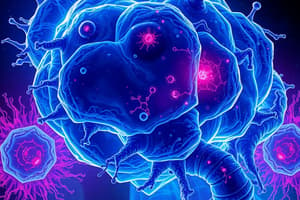Podcast
Questions and Answers
What is the primary characteristic of physiologic atrophy?
What is the primary characteristic of physiologic atrophy?
- Caused by disease
- Reversible process
- Involves cell death
- Natural due to aging (correct)
Which type of hypertrophy is characterized by an increase in workload and endocrine stimulation?
Which type of hypertrophy is characterized by an increase in workload and endocrine stimulation?
- False hypertrophy
- True hypertrophy (correct)
- Compensatory hypertrophy
- Pathologic hypertrophy
What describes metaplasia?
What describes metaplasia?
- Irreversible cell death
- Increase in cell size only
- Adaptation to chronic irritation by cell type replacement (correct)
- Permanent inability to adapt
What is the main difference between hyperplasia and hypertrophy?
What is the main difference between hyperplasia and hypertrophy?
Which mechanism is a common cause of cell injury?
Which mechanism is a common cause of cell injury?
Which type of cell death is characterized as pathologic and involves severe damage to cell membranes?
Which type of cell death is characterized as pathologic and involves severe damage to cell membranes?
Dysplasia is associated with which of the following?
Dysplasia is associated with which of the following?
What is an essential feature of neoplasia?
What is an essential feature of neoplasia?
What type of retrogressive change involves the incomplete or defective development of tissue or organ without resemblance to the adult structure?
What type of retrogressive change involves the incomplete or defective development of tissue or organ without resemblance to the adult structure?
Which option describes a failure of an organ to reach its adult size due to incomplete development?
Which option describes a failure of an organ to reach its adult size due to incomplete development?
What generally describes the cellular adaptation involving an acquired decrease in size of a normal mature tissue or organ?
What generally describes the cellular adaptation involving an acquired decrease in size of a normal mature tissue or organ?
Which term refers to changes that result in the enlargement of cells or tissues?
Which term refers to changes that result in the enlargement of cells or tissues?
What condition is characterized by the complete non-appearance of an organ?
What condition is characterized by the complete non-appearance of an organ?
Which type of change is primarily due to aberrations in cell growth?
Which type of change is primarily due to aberrations in cell growth?
What term is used to describe a failure of an organ to form an opening?
What term is used to describe a failure of an organ to form an opening?
What is the characteristic of progressive changes in terms of cell adaptation?
What is the characteristic of progressive changes in terms of cell adaptation?
What is the primary cause of apoptosis in cells?
What is the primary cause of apoptosis in cells?
Which type of necrosis is characterized by a cheese-like appearance due to tuberculous infection?
Which type of necrosis is characterized by a cheese-like appearance due to tuberculous infection?
What cytoplasmic change is associated with necrosis allowing for increased eosinophilia?
What cytoplasmic change is associated with necrosis allowing for increased eosinophilia?
Which of the following is NOT a recognizable change associated with nuclear necrosis?
Which of the following is NOT a recognizable change associated with nuclear necrosis?
Which type of necrosis involves the destruction of adipose tissue due to the release of activated pancreatic lipase?
Which type of necrosis involves the destruction of adipose tissue due to the release of activated pancreatic lipase?
In inflammation, which cardinal sign is characterized by increased blood flow to a site?
In inflammation, which cardinal sign is characterized by increased blood flow to a site?
What is the main characteristic of liquefactive necrosis?
What is the main characteristic of liquefactive necrosis?
What is the term used to describe the antibodies and antigen complexes deposited in arterial walls in fibrinoid necrosis?
What is the term used to describe the antibodies and antigen complexes deposited in arterial walls in fibrinoid necrosis?
Flashcards are hidden until you start studying
Study Notes
Retrogressive Changes
- Decrease in size of normal mature tissue/organ
- Types
- Developmental Changes - Aplasia - Incomplete or defective development of tissue/organ bearing no resemblance to the adult structure - Agenesis - Complete non-appearance of the organ - Hypoplasia - Failure of organ to reach its adult size due to incomplete development - Atresia - Failure of an organ to form an opening
- Atrophy - Physiologic Atrophy - Natural, due to aging - Pathologic Atrophy - Due to disease
Progressive Changes
- Hypertrophy - Increase in size of tissues/organs due to increase in size of individual cells
- Types - True Hypertrophy - Due to increased workload and endocrine stimulation - False Hypertrophy - Due to edema fluid and connective tissue proliferation - Compensatory Hypertrophy - Occurs when one of the paired organs has been removed or functional insufficiency
- Hyperplasia - Increase in size due to increase in number of cells
- Types - Physiologic Hyperplasia - Natural - Pathologic Hyperplasia - Due to disease
Degenerative Changes
- Metaplasia - Replacement of one type of cell to another
- Adaptation to chronic injury/irritation
- Reversible, prone to malignancy
- Dysplasia - "Disordered growth"
- Variation in size, shape and orientation associated with chronic inflammation and protracted irritation
- Anaplasia - Regressive change in adult's cells towards a more primitive or embryonic cell type
- Utilized as a criterion towards malignancy
- Neoplasia - Continuous abnormal proliferation of cells without control
Studying That Suits You
Use AI to generate personalized quizzes and flashcards to suit your learning preferences.




